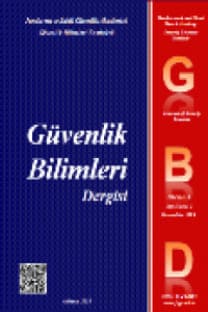STRATEJİ, ÖRGÜTLENME VE MOTİVASYONUYLA KENDİNE ÖZGÜ BİR TERÖRİST ÖRGÜT: FETÖ
FETÖ, Terör, Strateji, Motivasyon, Örgütlenme
A SUI GENERIS TERRORIST ORGANIZATION WITH ITS STRATEGY, ORGANIZATION AND MOTIVATION: FETO
FETO, Terror, Strategy, Motivation, Organization,
___
- Ankara C. Başsavcılığı 2016/109268 soruşturma numaralı, 2017/19707 esas numaralı, 2017/3376 numaralı iddianame
- Army, U. S. (2007). A military guide to terrorism in the twenty-first century.US Army TRADOC G2 Handbook.
- Arquilla, J. ve Ronfeldt, D. (2001). Networks and netwars: The future of terror, crime, and militancy. Rand Corporation.
- Arquilla, J., ve Ronfeldt, D. (1999). The advent of netwar: Analytic background. Studies in Conflict and Terrorism, 193-206.
- Arslan, H. (2017) Rüya Metaforu Üzerinden Din İstismarı: FETÖ Örneği. Liberal Düşünce Dergisi, (87), 33-47.
- Avcı, E. (2011). Radikal islamcı terörizmin meşru gösterilmesi: Türkiye Hizbullahı örneği. (Yayımlanmamış Doktora Tezi). Kara Harp Okulu, Ankara.
- Bartholdy, J. L. (1821). Memoirs of the Secret Societies of the South of Italy: Particulary the Carbonari. John Murray.
- Bernstein, M., ve Crosby, F. (1980). An empirical examination of relative deprivation theory. Journal of Experimental Social Psychology, 16(5), 442-456.
- Boot, M. (2013). Görünmeyen ordular: Gerilla tarihi. İnkılap Kitabevi.
- Box, M., & McCormack, G. (2004). Terror in Japan: The Red Army (1969-2001) and Aum Supreme Truth (1987-2000). Critical Asian Studies, 91-112.
- Crenshaw, M. (2006). Have motivations for terrorism changed. Tangled roots: Social and psychological factors in the genesis of terrorism, 11, 51-57.
- Cronin, A. K. (2003). Behind the curve: Globalization and international terrorism. International security, 27(3), 30-58.
- Davis, M. (2007). The FLN’s Strategy for Gaining an Independent Algeria, 1954-1962. Ronald E. McNair Program, 1-13.
- Demir, C. K. (2017). Sebeplerinden Mücadele Yöntemlerine Etnik Ayrılıkçı Terörizm: PIRA, ETA, PKK. Ankara: Nobel Akademik Yayıncılık.
- Demir, H. (2019). Radikal/yıkıcı kült gruplar: Kavram ve teorik bir çerçeve. 1-13.
- Dishman, C. (2016). Terrorist and criminal dynamics: A look beyond the horizon. Matfess, H. and Miklaucic, M (Ed.), Beyond Convergence: World Without Order, 137-155.
- Erickson, E. J. (2013). Ottomans and Armenians: A Study in Counterinsurgency. Springer.
- FETÖ, Din İstismarı, İhanet ve Tehdit, İç Güvenlik Stratejileri Dairesi Başkanlığı
- Fromkin, D. (1975). The strategy of terrorism. Foreign Affairs,53(4), 683-698.
- Frost, T. (1876). The Secret Societies of the European Revolution, 1776-1876 (Cilt. 1). Tinsley Bros.
- Frost, T. (1876). The Secret Societies of the European Revolution, 1776-1876 (Cilt 2). Tinsley Bros.
- Hâkimler ve Savcılar Yüksek Kurulu Genel Kurul Kararı, Karar No: 2016/426, Tutanak No:17, 24.08.2016, https://www.resmigazete.gov.tr/eskiler/2016/08/ 20160825-5.pdf. Erişim Tarihi: 24.10.2019
- Heger, L., Jung, D., ve Wong, W. H. (2012). Organizing for resistance: How group structure impacts the character of violence. Terrorism and Political Violence,24(5), 743-768.
- Hoffman, B., The End of Empire and the Origins of Contemporary Terrorism, Inside Terrorism (p. 43-62) https://en.wiktionary.org/wiki/baracca, Erişim Tarihi: 23.10.2019 https://www.britannica.com/topic/millennialism. (Erişim Tarihi: 13.09.2019)
- Hudson, R. A. (1999). The sociology and psychology of terrorism: Who becomes a terrorist and why? Library of Congress Washington Dc Federal Research Div.
- Hutchinson, M. C. (1972). The concept of revolutionary terrorism. Journal of Conflict Resolution, 16(3), 383-396.
- Kalyvas, S. N. (2003). The ontology of “political violence”: action and identity in civil wars. Perspectives on politics,1(3), 475-494.
- Kilberg, J. (2012). A basic model explaining terrorist group organizational structure. Studies in Conflict & Terrorism, 35(11), 810-830.
- Kydd, A. H. ve Walter, B. F. (2006). The strategies of terrorism. International security, 31(1), 49-80.
- Laqueur, W. (2002). A history of terrorism. Transaction Publishers
- Laqueur, W. (2004). Voices of Terror: Manifestos. Writings and Manuals of AL Qaeda.
- Marighella, C. (2011). Minimanual of the urban guerrilla. Praetorian Press LLC.
- Miller, M. A. (2003). The intellectual origins of modern terrorism in Europe. Terrorism in context, 28-41.
- Novak, D. (1954). Anarchism and individual terrorism. Canadian Journal of Economics and Political Science, 20(2), 176-184.
- Olson, K. B. (1999). Aum Shinrikyo: Once and Future Threat? Emerging Infectious Diseases, 5(4), 513-516.
- Price, H. E. (1977). The strategy and tactics of revolutionary terrorism. Comparative Studies in Society and History, 19(1), 52-66.
- Rapoport, D. C. (2001). The fourth wave: September 11 in the history of terrorism. Current History,100(650), 419.
- Rapoport, D. C. (2002). The Four Waves of Rebel Terror and September. Anthropoetics, (1).
- Rath, R. J. (1964). The Carbonari: Their Origins, Initiation Rites, and Aims. The American Historical Review, 69(2), 353-370.
- Shiver, C. (1964). The Carbonari. Social Science, 234-241.
- Simon, J. D. (2008). The forgotten terrorists: Lessons from the history of terrorism. Terrorism and political violence, 20(2), 195-214.
- TBMM. (2017). ‘‘FETÖ/PDY Meclis Araştırma Komisyonu Raporu’’ http://altinoz.com.tr/wp-content/uploads/2017/05/Rapor_26.05.pdf. Erişim tarihi: 02.09.2019.
- Thorup, M. (2008). The anarchist and the partisan—Two types of terror in the history of irregular warfare. Terrorism and Political Violence, 20(3), 333-355.
- Wilkinson, P. (2000). The strategic implications of terrorism. Terrorism and political violence: A sourcebook, 19-49.
- ISSN: 2147-2912
- Yayın Aralığı: Yılda 2 Sayı
- Başlangıç: 2012
- Yayıncı: JANDARMA VE SAHİL GÜVENLİK AKADEMİSİ
ANKLAV, EKSKLAV VE UÇ TOPRAKLAR-GÜVENLİK İLİŞKİSİ
TURİZMDE GÜVENLİK ALGISININ TÜRKİYE EKONOMİSİNE ETKİSİ
BİRLEŞİK KRALLIKTA SİBER EKONOMİK SUÇLARA YÖNELİK KOLLUK FAALİYETLERİ SORUNLARININ İNCELENMESİ
Naci AKDEMİR, Bülent SUNGUR, Bürke Uğur BAŞARANEL
NATO’NUN YENİ OPERASYON ALANI: SİBER UZAY
RADİKALLEŞMENİN ÖLÇÜLMESİ: AŞIRICILIK ÖLÇEĞİNİN VE AŞIRICILIK ÖLÇEĞİ İLE İLİŞKİLİ ŞİDDET YANLILIĞI
ULUSLARARASI GÜVENLİĞİN TARİHSEL GELİŞİMİ VE POST-MODERN GÜVENLİK DÖNEMİ
STRATEJİ, ÖRGÜTLENME VE MOTİVASYONUYLA KENDİNE ÖZGÜ BİR TERÖRİST ÖRGÜT: FETÖ
Arman SERT, Cenker Korhan DEMİR, Engin AVCI
SU VE SU GÜVENLİĞİ KONUSUNDA İKLİM DEĞİŞİKLİĞİNE UYUM TABANLI STRATEJİLER: DAKKA VE ANKARA ÖRNEĞİ
AKILLI KENTLERDE VERİNİN GİZLİLİĞİ VE GÜVENLİĞİ: İLKELER VE YAKLAŞIMLAR
